
Kickboxing is a full-contact combat sport and a form of boxing based on punching and kicking. The fight takes place in a boxing ring, normally with boxing gloves, mouth guards, shorts, and bare feet to favor the use of kicks. Kickboxing is practiced for self-defense, general fitness, or for competition. Some styles of kickboxing include: Karate, Muay Thai, Japanese kickboxing, Lethwei, Sanda, and Savate.

A kick is a physical strike using the leg, in unison usually with an area of the knee or lower using the foot, heel, tibia (shin), ball of the foot, blade of the foot, toes or knee. This type of attack is used frequently by hooved animals as well as humans in the context of stand-up fighting. Kicks play a significant role in many forms of martial arts, such as capoeira, karate, kickboxing, kung fu, MMA, Muay Thai, pankration, pradal serey, savate, sikaran, silat, taekwondo, vovinam, and Yaw-Yan. Kicks are a universal act of aggression among humans.

Martial arts are codified systems and traditions of combat practiced for a number of reasons such as self-defence; military and law enforcement applications; competition; physical, mental, and spiritual development; entertainment; and the preservation of a nation's intangible cultural heritage.

Muay Thai, sometimes referred to as Thai boxing, is a combat sport that uses stand-up striking, sweeps, and various clinching techniques. This discipline is known as the "Art of eight limbs", as it is characterised by the combined use of fists, elbows, knees and shins. Muay Thai became widespread internationally in the late 20th to 21st century, when Westernised practitioners from Thailand began competing in kickboxing and mixed-rules matches as well as matches under Muay Thai rules around the world. The professional league is governed by The Professional Boxing Association of Thailand (P.A.T.), sanctioned by The Sports Authority of Thailand (S.A.T.).
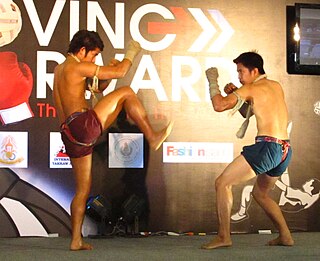
Muay Boran or originally Toi Muay is an umbrella term for the ancient unarmed martial arts of Thailand prior to the introduction of modern equipment and rules in the 1930s.

A strike is a directed, forceful physical attack with either a part of the human body or with a handheld object, intended to cause blunt or penetrating trauma upon an opponent.
The following outline is provided as an overview of and topical guide to martial arts:
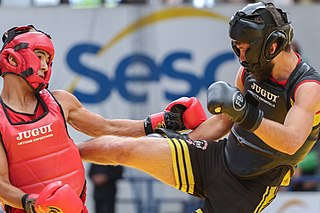
San Da, formerly San Shou, is the official Chinese kickboxing full-contact combat sport. Sanda is a fighting system which was originally developed by the Chinese military based upon the study and practices of traditional Chinese martial arts and modern combat fighting techniques; it combines boxing and full-contact kickboxing, which includes close range and rapid successive punches and kicks, with wrestling, takedowns, throws, sweeps, kick catches, and in some competitions, even elbow and knee strikes.
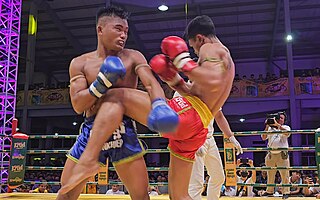
Kun Khmer or Pradal Serey is a combat sport that originated in Cambodia. The official Khmer name of the sport is Kbach Kun Pradal Khmer. In Khmer, pradal means fighting or boxing and serey means free. Thus, pradal serey may be translated as "free fighting" or "free boxing". The sport consists of stand up striking and clinch fighting where the objective is to knock an opponent out, force a technical knockout, or win a match by points.

Lethwei or Burmese boxing is a full contact combat sport from Myanmar that uses stand-up striking including headbutts. Lethwei is considered to be one of the most brutal martial arts in the world, as the sport is practiced bareknuckle with only tape and gauze while fighters are allowed to strike with their fists, elbows, knees, and feet, and the use of headbutts is also permitted. Disallowed in most combat sports, headbutts are important weapons in a Lethwei fighter's arsenal, giving Lethwei its name of the "Art of nine limbs". This, combined with its bareknuckle nature, gave Lethwei a reputation for being one of the bloodiest and most violent martial arts. Although popular throughout modern Myanmar, Lethwei has been primarily and historically associated with the Karen people of the Kayin State; vast majority of competitive Lethwei fighters are ethnolinguistically of Karen descent.
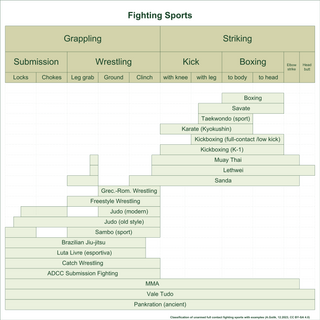
A combat sport, or fighting sport, is a contact sport that usually involves one-on-one combat. In many combat sports, a contestant wins by scoring more points than the opponent, submitting the opponent with a hold, disabling the opponent, or attacking the opponent in a specific or designated technique. Combat sports share a long history with the martial arts.

A roundhouse kick is a kick in which the practitioner lifts the knee while turning the supporting foot and body in a semicircular motion, extending the leg striking with the lower part of the shin and/or the instep. The ball of the foot can also be used to strike the target and is preferable when power breaking thick boards. This type of kick is utilized in many different martial arts and is popular in both non-contact and full-contact martial arts competitions. The kick has many variations based on stance, leg movement, striking surface, and the height of the kick.

A knee strike is a strike with the knee, either with the kneecap or the surrounding area. Kneeing is a disallowed practice in many combat sports, especially to the head of a downed opponent. Styles such as kickboxing and several mixed martial arts organizations allow kneeing depending on the positioning of the fighters. Knee strikes are native to the traditional Southeast Asian martial arts and traditional Okinawan martial arts.

Clinch fighting is the part of stand-up fighting where the combatants are grappling in a clinch, typically using clinch holds. Clinching the opponent can be used to eliminate the opponent's effective usage of some kicks, punches, and melee weapons. The clinch can also be used as a medium to switch from stand-up fighting to ground fighting by using takedowns, throws or sweeps.
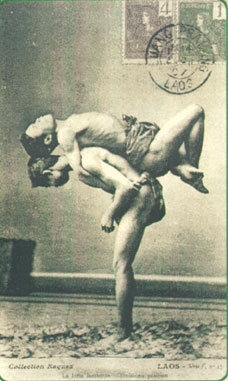
Muay Lao is an ancient combat sport from Laos. It incorporates punches, kicks, elbow, and knee strikes. It can be traced back to the 15th century when it was used for military combat during the Lan Xang dynasty. It is similar to Muay Thai from Thailand and Pradal Serey from Cambodia. Muay Lao was an event at the 2009 Southeast Asian Games in Vientiane.

Sityodtong USA, also known as Team Sityodtong, is a Muay Thai and mixed martial arts training camp based out of Somerville, Massachusetts. The headquarters of Sityodtong Camp is in Pattaya, Thailand. Its Grandmaster is Yodtong Senanan and he has produced 57 Muay Thai Champions, the largest number in the history of Muay Thai in Thailand. The owner and head trainer of Sityodtong Boston, Mark DellaGrotte, is a teacher of various styles of Muay Thai such as Mae Mai Muay Thai, Pradal Serey, Muay Boran, Muay Lao, and also Burmese Boxing. The team members includes MMA fighters such as Marcus Davis, Dale Hartt, and Patrick Côté.
Musti-Yuddha is a traditional combat sport originating from the Indian subcontinent. The term literally means "fist combat", from the Sanskrit words muṣṭi (fist) and yuddha. While this would originally have been used as a general term for any boxing art, today it usually refers to muki boxing from Varanasi, the only surviving unarmed style. In the Punjab there still exists an armed form of boxing called loh-musti in which the fighters wear an iron ring on one hand, although it is no longer used for sparring.
The traditional martial arts of the Mainland Southeast Asia are related to one another, and as a group to Indian martial arts. The most salient common feature is Mainland Southeast Asia kickboxing. The region of Mainland Southeast Asia is believed to be the land of Suvarnabhumi that ancient Indians mentioned in Buddhist text and Hindu text. In 790 A.D., a Khmer prince who grew up abroad by the name of Jayavarman II returned to unify the Khmer civilization. In 802 A.D., Jayavarman II established the Khmer Empire, the precursor to modern Cambodia, and declared himself the Chakravatin. Around 850 A.D., Pagan, the ancestor of modern-day Burma, was established by Tibeto-Burman speakers. For 200 years, Pagan remained a small principality until the reign of King Anawrahta. In 1238 A.D., Thailand's first state, Sukhothai, was started when the residents declared independence from the Khmer Empire. In 1353 A.D., Laos's first state, Lan Xang, was started by Fa Ngum with the assistance of the Khmer from Angkor.
Too Too was a Burmese Lethwei fighter who competed in World Lethwei Championship. He was the former WLC Middleweight World champion and was undefeated under traditional Lethwei rules, holding the 75 kg Lethwei Golden Belt since 2015 until his death in 2023, while in captivity by the Tatmadaw. He also competed in a Lethwei superfight at Kunlun Fight 25 in Slovakia.



















